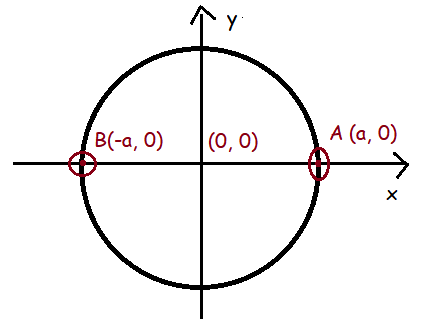PROBLEMS BASED ON PROPERTIES OF DISTANCE IN COORDINATE GEOMETRY
Subscribe to our ▶️ YouTube channel 🔴 for the latest videos, updates, and tips.
Problem 1 :
A (–1, 1), B (1, 3) and C (3, a) are points and if AB = BC, then find ‘a’.
Solution :
Distance between two points = √(x2 - x1)2 + (y2 - y1)2
A (–1, 1) and B (1, 3)
= √(1+1)2 + (3-1)2
= √22 + 22
= √(4+4)
AB = √8
B (1, 3) and C (3, a)
= √(1-3)2 + (3-a)2
= √(-2)2 + (3-a)2
BC = √4 + (3-a)2
AB = BC
√8 = √4 + (3-a)2
Taking squares on both sides
8 = 4 + (3-a)2
8 = 4 + 9 + a2 - 6a
8 = 13 + a2 - 6a
a2 - 6a + 13 - 8 = 0
a2 - 6a + 5 = 0
(a - 1)(a - 5) = 0
a = 1 and a = 5
Problem 2 :
The abscissa of a point A is equal to its ordinate, and its distance from the point B(1, 3) is 10 units, What are the coordinates of A?
Solution :
Since the point A is equal to its ordinates
x = y
Let A(x, x)
Distance between the points A and B :
A(x, x) B(1, 3)
√(1-x)2 + (3-x)2 = 10
Taking squares on both sides
(1-x)2 + (3-x)2 = 100
1 - 2x + x2 + 9 - 6x + x2 = 100
2x2 - 8x + 10 - 100 = 0
2x2 - 8x - 90 = 0
Divide the entire equation by 2, we get
x2 - 4x - 45 = 0
(x - 9)(x + 5) = 0
x = 9 and x = -5
A(9, 9) or B(-5, -5)
Problem 3 :
The point (x, y) is equidistant from the points (3, 4) and
(–5,6). Find a relation between x and y.
Solution :
Let the points be p (x, y) A(3, 4) and B(-5, 6)
PA = PB
√(3-x)2 + (4-y)2 = √(-5-x)2 + (6-y)2
Taking squares on both sides
(3-x)2 + (4-y)2 = (5+x)2 + (6-y)2
9 - 6x + x2 + 16 - 8y + y2 = 25 + 10x + x2 + 36 - 12y + y2
-6x - 10x - 8y + 12y + 25 - 61 = 0
-16x + 4y - 36 = 0
4x - y + 9 = 0
y = 4x + 9
Problem 4 :
Let A(2, 3) and B(2, –4) be two points. If P lies on the x-axis, such that AP = (3/7)AB, find the coordinates of P.
Solution :
Since the point P lies on x-axis, the y-coordinate will be 0.
A(2, 3) P(x, 0)
= √(x - 2)2 + (0 - 3)2
= √(x - 2)2 + 9 ------(1)
A(2, 3) B(2, -4)
= √(2 - 2)2 + (-4 - 3)2
= √02 + (-7)2
= 7 ------(2)
AP = (3/7)AB
√(x - 2)2 + 9 = (3/7) 7
(x - 2)2 + 9 = 32
x2 - 4x + 4 + 9 - 9 = 0
x2 - 4x + 4 = 0
(x - 2) (x - 2) = 0
x = 2 and x = 2
Hence the point P is (2, 0)
Problem 5 :
Show that the point (11, 2) is the center of the circle passing through the points (1, 2), (3, –4) and (5, –6)
Solution :
Let the center point be O (11, 2)
A(1, 2) B(3, -4) and C(5, -6)
AO = BO = CO
O (11, 2) and A(1, 2)
= √(1 - 11)2 + (1 - 11)2
= √100 + 100
= √200
O (11, 2) and B(3, -4)
= √(3 - 11)2 + (-4 - 2)2
= √(-8)2 + (-6)2
= √64 + 36
= √100
O (11, 2) and C (5, –6)
= √(5 - 11)2 + (-6 - 2)2
= √(-6)2 + (-8)2
= √36 + 64
= √100
Hence the given point (11, 2) is the center of the circle.
Problem 6 :
The radius of a circle with center at origin is 30 units. Write the coordinates of the points where the circle intersects the axes. Find the distance between any two such points.
Solution :

From the diagram given above, we come to know that the distance between the points (0, 0) and (a, 0) is 30 units.
√(0 - a)2 + (0 - 0)2 = 30
√(-a)2 = 30
a = 30
it is clearly shown that circle intersects the co-ordinate axes at four points. and that are (30, 0), (-30, 0), (0, 30) and (0, -30).
now, distance between (30,0) and (0,30)
= √[(30 - 0)2 + (0 - 30)2]
= √[302 + 302]
= √[900 + 900]
= √1800
= 30√2 units
Similarly , you can find distance between any such two points.
for better understanding, let
A = (30, 0)
B = (0, 30)
C = (-30, 0)
D = (0, -30)
Then,
AB = BC = CD = DA = 30√2 units
Subscribe to our ▶️ YouTube channel 🔴 for the latest videos, updates, and tips.
Kindly mail your feedback to v4formath@gmail.com
We always appreciate your feedback.
About Us | Contact Us | Privacy Policy
©All rights reserved. onlinemath4all.com
Recent Articles
-
Quantitative Reasoning Questions and Answers
Dec 13, 25 12:45 PM
Quantitative Reasoning Questions and Answers -
Coin Tossing Probability
Dec 13, 25 10:11 AM
Coin Tossing Probability - Concept - Sample Space - Formula - Solved Problems -
10 Hard SAT Math Questions (Part - 39)
Dec 11, 25 05:59 PM
10 Hard SAT Math Questions (Part - 39)